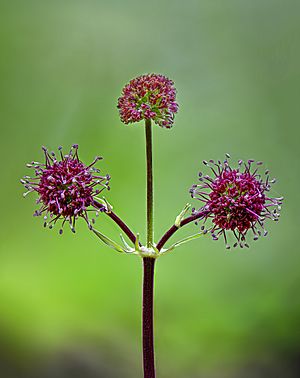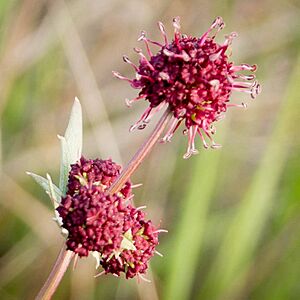Purple sanicle facts for kids
Quick facts for kids Purple sanicle |
|
|---|---|
 |
|
| Scientific classification | |
| Genus: |
Sanicula
|
| Species: |
bipinnatifida
|
Sanicula bipinnatifida is a type of flowering plant. It belongs to the parsley family. People often call it by its common names: purple sanicle, purple blacksnakeroot, or shoe buttons.
Where It Lives
This plant grows naturally along the west coast of North America. You can find it from British Columbia in Canada all the way down to Baja California in Mexico. It likes to grow in many different places. These include open grasslands, forests, and even on mountain slopes. It especially likes soils called serpentine soils.
What It Looks Like
The purple sanicle is a plant that lives for many years. It grows from a main root called a taproot. This root helps it get water and nutrients from deep in the ground. The plant can grow up to about 60 centimeters tall. That's about two feet!
Its color can be bright green or even dark purple. The leaves grow on long stems called petioles. These petioles can be up to 19 centimeters long. The leaves themselves are divided into several parts, and each part has jagged edges like teeth.

Its Flowers
The flowers of the purple sanicle grow in clusters. These clusters are called inflorescences. Each cluster looks like one big flower, but it's actually made of many tiny flowers. Some of these tiny flowers have both male and female parts (called bisexual). Others only have male parts (called male-only flowers). The petals are very small and can be reddish, purple, or yellow. They often have a slight curve to them.
Its Fruits
After the flowers bloom, the plant produces small fruits. These fruits are only a few millimeters long. They are covered in tiny prickles, which helps them stick to things and spread their seeds.
See also
 In Spanish: Sanicula bipinnatifida para niños
In Spanish: Sanicula bipinnatifida para niños

